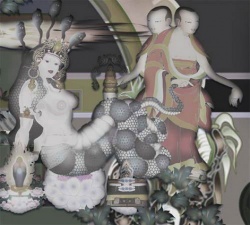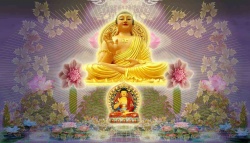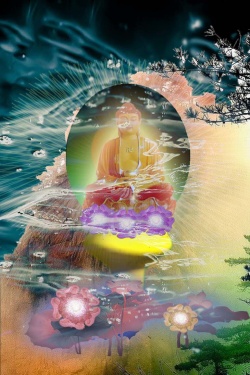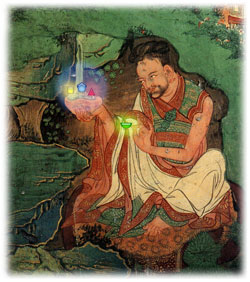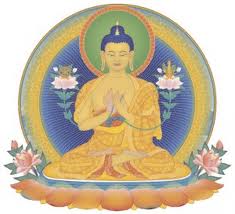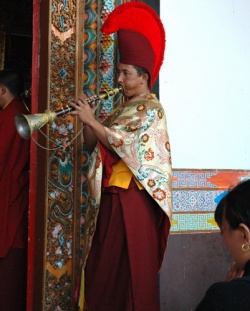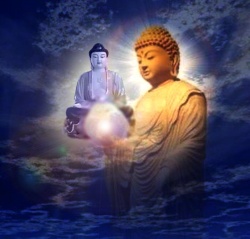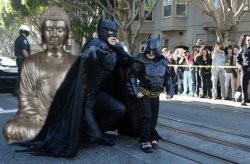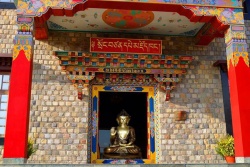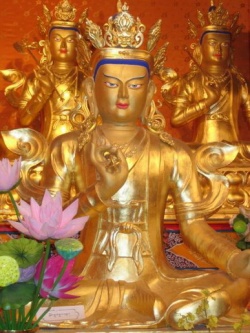Samadhiraja Sutra
The Samādhirāja Sūtra or Candrapradīpa Sūtra (Sanskrit) is a Buddhist sutra dating to c. 2nd century CE. It has been called "a text of capital importance for the Mahayana philosophical school called Madhyamaka . . . quoted extensively in sastric literature."
Name and etymology
Commonly known as the King of Samadhi Sutra (Samādhirājasūtra, Tib. ting nge 'dzin gyi rgyal po'i mdo), it is also known as the Moon Lamp Sutra (Skt. Candrapradīpa Sutra, Tib. zla ba sgron me’i mdo).
The full Tibetan title in the Kanjur is 'Phags-pa chos thams-cad kyi rang-bzhin mnyam-pa-nyid rnam-par spros-pa ting-nge-'dzin gyi rgyal-po zhes byaba theg-pa chen-po'i mdo.
This corresponds to Sarva-dharmasvabhavā-samatā-vipancita-samādhirāja-nāma-mahāyāna-sūtra, which is the Sanskrit title given in the sutra itself. The Chinese have preferred Yueh-teng san-mei ching, corresponding to *Candrapradīpa-samādhisūtra.
Historical significance
Scholars Gomez and Silk write, "Although it is questionable how much the sutra itself was read in Tibet, it is often cited in Tibetan philosophical literature, probably mostly on the basis of quotations found in Indian texts.
The sutra seems to have had a less glorious history in the Far East, where it was translated several times but was seldom quoted.
It is not part of any of the sutra collections within the Tibetan and Chinese Canons, though it is found as an independent text in both.
In Nepal the Samādhirāja Sūtra was counted as one of the 'Nine Dharmas,' a set of texts so highly revered that its manuscripts were used as objects of worship."
In the Kagyu lineage
The Samādhirāja Sūtra is often cited as an important source for śamatha instructions by the Kagyu tradition, particularly via commentary by Gampopa, although scholar Andrew Skilton, who has studied the Samādhirāja Sūtra extensively, reports that the sūtra itself "contains no significant exposition of either meditational practices or states of mind."
It is asserted in the Kagyu tradition that the Samādhirājasūtra predicted the dharma activity of Gampopa and the Karmapas. Düsum Khyenpa (Dus gsum Mkhyen pa, 1110–1193), the first Karmapa, was a disciple of the Tibetan master Gampopa.
A gifted child who studied dharma (Buddhist teachings) with his father from an early age and who sought out great teachers in his twenties and thirties, he is said to have attained enlightenment at the age of fifty while practicing dream yoga. He was henceforth regarded as the Karmapa, a manifestation of Avalokitesvara (Chenrezig), whose coming was predicted in the Samadhiraja Sutra and the Lankavatara Sutra.
Legend tells that in a previous eon, in a former life as an accomplished yogi, the Karmapa attained the eighth level or bhumi of the bodhisattvas.
At this time, 100,000 dakinis (female buddhas) manifested their hair as a crown (the sambhogakaya ornamentation and antecedent of the Black Crown, the nirmanakaya), and offered it to the Karmapa as a symbol of his accomplishment.
Dusum Khyenpa, the 1st Karmapa, was regarded as an emanation of that yogi and his appearance was predicted by the historical Buddha Shakyamuni in the Samadhiraja Sutra:
- “A bodhisattva with the lion’s roar will appear. He will use the power he achieved in deep meditation to benefit countless beings. By seeing, hearing, touching or thinking of him, they will be led to happiness”
The Samadhiraja Sutra is part of the Kagyupa transmission known as the Do Tenzin Gyalpo teaching (The King of Samadhi Teaching).
Content and themes
According to Gomez and Silk, "The sūtra declares its main theme to be a particular samādhi that is supposed to be the key to all elements in the path and to all the virtues and merits of buddhas and bodhisattvas.
This state of mind, or spiritual practice, is called "the samādhi that is manifested as the sameness of the essential nature of all dharmas" (sarva-dharma-svabhavā-samatā-vipañcita-samādhi).
One may be tempted to assume that this refers to one particular form or state of contemplation; however, here the term "samādhi" is understood in its broadest signification.
This samādhi is at the same time the cognitive experience of emptiness, the attainment of the attributes of buddhahood, and the performance of a variety of practices or daily activities of a bodhisattva—including service and adoration at the feet of all buddhas.
The word samādhi is also used to mean the sūtra itself.
Consequently, we can speak of an equation, sūtra = samādhi = śūnyatā, underlying the text. In this sense the title Samādhirāja expresses accurately the content of the sūtra."
- The Samādhirāja . . . has been identified consistently with the Madhyamaka tradition. Regamey has shown, however, that the Samādhirāja cannot be considered a clear representative of a single philosophical tradition.
The sutra's doctrinal position cannot be described accurately as unambiguously Mādhyamika, or even as pure sunyavada. That is to say, one would find it difficult to show that the sutra is the product of, or a legitimate representative of, Mādhyamika circles.
Still, it is obvious that the sutra was considered highly authoritative by Mādhyamika scholastics and ignored by Yogācāra authors.
In spite of its clearly defined philosophical position, the Samādhirāja does not fit our stereotype of a sectarian document. It is difficult to set it in a specific sectarian context with any degree of historical certainty.
Furthermore, in terms of religious types it is eclectic and universalistic, so that it would be pointless to attempt to box it in some general category.
It makes room for more than one dimension of Buddhist religion: meditation, worship of the Buddhas, the cult of the Book, philosophical speculation, rehearsal of myth (in avadanā style) and so on.
At the present stage of our knowledge of the history of Mahāyāna sutra literature, we can only say that the Samādhirāja played an important role as a "proof text" for the Madhyamaka. But it seems unlikely that the text was composed with such a role in mind.
It would be more accurate to say that it was conceived as a representative text of general doctrine, with a strong leaning towards a philosophic position that can be described as akin to that of the Madhyamaka.
Because of its comprehensive, almost encyclopedic, character, it offered a wider range of ideas from which to quote than did other texts.
Supushpachandra, a bodhisattva who purportedly ignored a commanded by King Shuradatta to abstain from teaching dharma and was executed, features prominently in the Samadhiraja sutra.
He is also mentioned by Shantideva in the chapter on meditation, verse 106 in A Guide to the Bodhisattva's Way Of Life.
Translations, versions, editions and recensions
The Samādhirāja sūtra is forty chapters long.
Tibetan
The Tibetan translation is located in the ninth volume (leaves 1-273) of mDo (unknown which edition of the Kangyur).
The Tibetan translators (Tibetan: lotsawa) were Śailendrabodhi and Dharmatāśīla, who both lived in the 9th century CE.
Chinese
There are three Chinese translations (三摩地王经). Only one of the three Chinese translations is complete. The complete translation was made by Narendrayaśa of the Northern Tshi dynasty in 557 CE. Of the incomplete translations, one was made by Shih-sien-kuṇ of the earlier Suṇ dynasty in CE 420-479.
English
- The first four chapters have been translated by Luis O. Gomez and Jonathan A. Silk.
- The fourth, sixth, seventh and ninth chapters were translated by John Rockwell in an MA thesis at Naropa Institute.
- The eleventh chapter was translated by Mark Tatz in his MA thesis at the University of Washington (1972).
- The eight, nineteenth and twenty-second chapters were translated by Konstanty Regamey.
- Thrangu Rinpoche has published an extensive commentary on this sutra.
Sanskrit
Full Devanagari along with English summary of chapters:
Quotations
Dudjom Rinpoche (1904–1987), a prominent Nyingma lama, quotes the Samādhirāja sūtra:
In thousands of world systems
The sūtras which I have explained
Differ in words and syllables but have the same meaning.
It is impossible to express them all,
But if one meditates deeply on a single word,
One comes to meditate on them all.
All the buddhas, as many as there are,
Have abundantly explained phenomena.
But if those skilled in meaning
Were to study only the phrase:
All things are emptiness
The doctrine of the Buddha would not be scarce.
Scholar Regamey translates a passage from the Samadhiraja Sutra discussing the Dharmakaya:
- ...the Body of the Tathagata [i.e. Buddha) should be defined as … having its essence identical with Space, invisible, surpassing the range of vision – thus is the Absolute Body to be conceived. Inconceivable, surpassing the sphere of thought, not oscillating between bliss and suffering, surpassing the illusory differentiation, placeless, surpassing the voice of those aspiring to the Knowledge of Buddhi, essential, surpassing passions, indivisible, surpassing hatred, steadfast, surpassing infatuation, explained by the indications of emptiness, unborn, surpassing birth, eternal from the standpoint of common experience, undifferentiated in the aspect of Nirvana, described in words as ineffable, quiescent in voice, homogenous with regard to conventional Truth, conventional with regard to the Absolute Truth – Absolute according to the true teaching.
Shantideva and Chandrakirti quoted from the Samadhiraja Sutra in the Śikṣāsamuccaya and the Mādhyamika-vṛtti, respectively.
Further reading
- Bennett, A.A.G. (1968). "Excerpts from the Samadhiraja-Sutra", The Maha Bodhi 77, Calcutta 1958, 295-298
- Cuppers, Christopher (1990). The IXth Chapter of the Samadhirajasutra. Stuttgart 1990
- Gomez, L.O. and J.A. Silk (eds). "The Sutra of the King of Samādhis, Chapters I-IV." Studies in the Literature of the Great Vehicle. University of Michigan: 1989
- Hartmann, Jens-Uwe (1996). "A note on a newly-identified palm-leaf manuscript of the Samadhirajasutra", Indo-Iranian Journal 39, 1996, 105-109
- Rockwell Jr., John (1980). Samadhi and Patient Acceptance: Four Chapters of the Samadhiraja-sutra. translated from the Sanskrit and Tibetan. M.A.Thesis, The Naropa Institute, Boulder, Colorado 1980
- Skilton, Andrew T. (1999). "Dating the Samadhiraja Sutra." Journal of Indian Philosophy 27, 1999, 635-652
- Skilton, Andrew T. (2000). "The Gilgit Manuscript of the Samadhiraja Sutra." Central Asiatic Journal 44, 2000, 67-86
- Skilton, Andrew T. (1999). '"Four Recensions of the Samadhiraja Sutra." Indo-Iranian Journal 42, 1999, 335-336
- Skilton, Andrew T. (?). "Samadhirajasutra", MonSC 2, 97-178
- Skilton, Andrew T. (2002). "State or statement? Samadhi in some early Mahayana Sutras", The Easterm Buddhist 34.2, 2002, 51-93
- Tatz, Mark (1972). Revelation in Madhyamika Buddhism. M.A.Thesis, University of Washington, 1972
- Thrangu Rinpoche. King of Samadhi: Commentaries on the Samadhi Raja Sutra and the Song of Lodrö Thaye. North Atlantic Books: 2004
